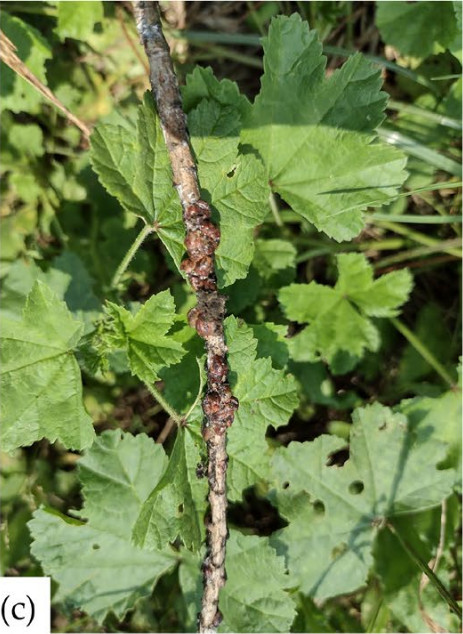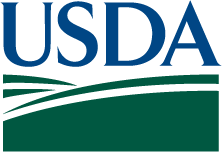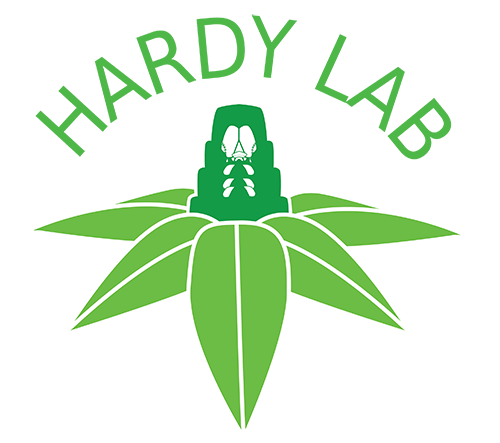Valid Names Results
Toumeyella parvicornis (Cockerell, 1897) (Coccidae: Toumeyella)Nomenclatural History
- Lecanium parvicorne Cockerell 1897k: 90. Type data: U.S.A.: Florida, on Pinus taeda and P. australis.. Syntypes, female, Type depository: London: The Natural History Museum, England, UK; Washington: United States National Entomological Collection, U.S. National Museum of Natural History, District of Columbia, USA; accepted valid name
- Toumeyella parvicornis (Cockerell, 1897); Cockerell 1902k: 452. change of combination
- Lecanium (Toumeyella) numismaticum Pettit & McDaniel 1920: 8. Type data: U.S.A.: Wisconsin, Trout Lake, on Scotch-pine.. Syntypes, female, Type depository: Auckland: New Zealand Arthropod Collection, Landcare Research, New Zealand; Washington: United States National Entomological Collection, U.S. National Museum of Natural History, District of Columbia, USA; junior synonym (discovered by WilliaKo1972, 171). Notes: Depository of type material unknown (Williams & Kosztarab, 1972).
Common Names
- pine tortoise scale HamonWi1984 Stimme1984
- Cocciniglia tartaruga KondoGa2022AP
- cochenille-tortue du pin KondoGa2022AP
- escama tortuga del pino KondoGa2022AP
Ecological Associates
Hosts:
Families: 1 | Genera: 1
- Pinaceae
- Pinus | HamonWi1984 MalumpHaMa2012
- Pinus banksiana | Bradle1973
- Pinus caribaea | Duenas2022 GaronnScVi2015 MalumpHaMa2012 | including var. bahamensis and var hondurensis
- Pinus contorta | Clarke2013
- Pinus echinata | WilliaKo1972
- Pinus elliottii | KondoGo2018
- Pinus glabra | HamonWi1984
- Pinus halepensis | VonEll2025
- Pinus mugo | WilliaKo1972
- Pinus nigra | GaronnFoRu2018
- Pinus palustris | Cocker1897k KondoGo2018 WilliaKo1972 | (= Pinus australis)
- Pinus pinaster | GaronnFoRu2018
- Pinus pinea | GaronnScVi2015 DiSoraTuBr2025
- Pinus resinosa | Clarke2013
- Pinus sylvestris | MillerWi1995GL WilliaKo1972
- Pinus taeda | Cocker1897v MillerWi1995GL
- Pinus virginiana | MillerWi1995GL WilliaKo1972
Foes:
Families: 6 | Genera: 15
- Aphelinidae
- Aphytis | MalumpHaMa2012
- Coccophagus albicoxa | MalumpHaMa2012
- Coccophagus immaculatus | MyartsRuCo2016a
- Coccophagus lycimnia | Clarke2013
- Coccophagus quaestor | MyartsRu2000
- Chamaemyiidae
- Leucopis | Clarke2013
- Coccinellidae
- Brachiacantha ursina | Duenas2022
- Chilocorus | MalumpHaMa2012
- Chilocorus bivulverus | MalumpHaMa2012
- Chilocorus stigma | Clarke2013
- Coccinella novemnotata | MalumpHaMa2012
- Coccinella transversoguttata | MalumpHaMa2012
- Coccinella trifasciata | MalumpHaMa2012
- Hippodamia convergens | Clarke2013
- Hyperaspis | Bradle1973 MalumpHaMa2012
- Hyperaspis binotata | MalumpHaMa2012
- Hyperaspis congressis | Bradle1973 Clarke2013 MalumpHaMa2012
- Hyperaspis conviva | Duenas2022
- Hyperaspis signata | MalumpHaMa2012
- Scymnus lacustris | MalumpHaMa2012
- Thalassa montezumae | GiovanMaSa2024
- Cordycipitaceae
- Akanthomyces muscarius | DiSoraTuBr2025
- Encyrtidae
- Encyrtus | Duenas2022
- Metaphycus | MyartsRuCo2016a
- Metaphycus flavus | GaronnFoRu2018
- Microterys fuscicornis | MalumpHaMa2012
- Pyralidae
- Laetilia coccidivora | MalumpHaMa2012
Associates:
Families: 1 | Genera: 3
- Formicidae
- Formica exsectoides | Clarke2013
- Formica obscuripes | Clarke2013
- Solenopsis invicta | Clarke2013
- Wasmannia auropunctata | EFSA2022
Geographic Distribution
Countries: 7
- Canada
- Manitoba | Bradle1973
- Ontario | BenDov1993
- France | EFSA2022
- Italy | GaronnScVi2015 TagareAvTu2022
- Mexico | MyartsRu2000
- Puerto Rico & Vieques Island
- Puerto Rico | MalumpHaMa2012
- Turks and Caicos Islands | MalumpHaMa2012
- United States
- Alabama | BenDov1993
- California | MalumpHaMa2012 VonEll2025
- Florida | Cocker1897k HamonWi1984
- Georgia | BenDov1993
- Illinois | BenDov1993
- Indiana | BenDov1993
- Iowa | HamonWi1984
- Kentucky | BenDov1993
- Louisiana | BenDov1993
- Massachusetts | BenDov1993
- Michigan | BenDov1993
- Minnesota | HamonWi1984
- Nebraska | HamonWi1984
- New Jersey | BenDov1993
- New Mexico | BenDov1993
- New York | BenDov1993
- North Carolina | BenDov1993
- North Dakota | HamonWi1984
- Ohio | BenDov1993
- Oklahoma | ClarkeNeDe1992
- Pennsylvania | Stimme1984
- South Carolina | BenDov1993
- South Dakota | HamonWi1984
- Tennessee | BenDov1993
- Texas | BenDov1993
- Virginia | WilliaKo1972
- West Virginia | BenDov1993
- Wisconsin | PettitMc1920
Keys
- KondoGo2018: pp.3 ( Adult (F) ) [Toumeyella species of Mexico]
- KondoGo2014: pp.2-3 ( Adult (F) ) [Taxonomic key to the Toumeyella species of Mexico based on the adult female]
- KondoPe2011: pp.230 ( Adult (F) ) [Taxonomic key to the Toumeyella species of Mexico based on the adult female]
- Koszta1996: pp.390 ( Adult (F) ) [Northeastern North America]
- HamonWi1984: pp.117 ( Adult (F) ) [USA, Florida]
- WilliaKo1972: pp.159 ( Adult (F) ) [USA, Virginia]
Remarks
- Systematics: The EPPO code1 (Griessinger and Roy, 2015; EPPO, 2019) for this species is: TOUMPA (EPPO, online). No genetic sequences are currently available from the closest relatives of T. parvicornis; accordingly, it clustered on its own in both Bayesian Inference and maximum likelihood trees but within the branch of Coccinae (all species belonging to the Coccini tribe). (DiSora, et al., 2023)
- Structure: See color photograph in Hamon & Williams (1984). Toumeyella parvicornis has both a bark and leaf form. The morphology of T. parvicornis differs depending on the feeding site, having bark and leaf forms (Hamon and Williams 1984; Williams and Kondo 2008). The pine tortoise scale has two morphologial forms based on the settling site; a shoot or twig form and a needle form. Adult females on the twigs are convex and hemispherical, sometimes with flattened edges, giving them the tortoise shell appearance. Females on the needles are elongate and their body width conforms to the needle width. (Clarke, 2013)
- Biology: Life history in Florida, USA (Quaintance, 1897), Canada (MacAloney, 1961; Rabkin & Lejeune, 1954). Develops one annual generation in Canada (Rabkin & Lejeune, 1954; MacAloney, 1961). Probably two generations per year in more southern regions of North America. A multi-voltine life-cycle is suspected in the Turks and Cacos Islands where several life stages have been observed occurring together. (Malumphy, et al., 2012) The south European climate conditions lead the species to close up to four overlapping generations, strongly increasing its damaging potential. (Di Sora, et al., 2023) Toumeyella parvicornis is phenotypically plastic with the number of generations varying according to abiotic conditions. The leaf form was reported as the dominant morph in the southern part of the United States, while the bark form is usually the most common in the northern area along the Canada–United States border. (Clark, 2013)
- Economic Importance: Infestations of this scale appeared on PInus taeda in Georgia, USA, following five applications of pyrethroids (Clark et al., 1992). A pest of seedlings and saplings (Rabkin & Lejeune, 1954). Scale infestations have caused such high levels of mortality of Caribbean pine that some areas contain no live trees or seedlings; The combination of high infestation levels on seedlings (needles become smothered in overlapping adult females) and massively reduced cone production by mature trees, threatens on-going recruitment into the pine population, with the prospect that the tree could be lost altogether from many areas. (Malumphy, et al., 2012) Malumphy, et al., 2016 confirmed that crawlers of T. parvicornis are carried on air-currents which helps to explain the rapid spread of the scale across the Turks & Caicos Islands.
- General Remarks: Good description and illustration of adult female by Williams & Kosztarab (1972), Hamon & Williams (1984) and by Kosztarab (1996). CDFA determined that the California distribution of Toumeyella parvicornis cited by Malumphy, et al. (2012) may have been made in error since they have no specimens and no record of its existence in that state. (pers. comm. Natalia von Ellenrieder)
Illustrations
Citations
- BascieChMa2025: biological importance, diagnosis, dispersal, ecology,
- BenDov1993: catalog, 331
- BertinIlSc2022: control,
- Bishop1998: distribution, ecology, host, life history, 1-119
- Bradle1973: biological control, distribution, host, 1113-1118
- Brown1939: distribution, host, 13
- Buckle1987: distribution, ecology, host, life history, 53-85
- CamachCh2015: distribution, ecology, host, 1, 9, 14
- Clarke2013: diagnosis, distribution, host, illustration,
- ClarkeNeDe1992: biological control, distribution, economic importance, host, 1246-1252
- Cocker1897k: description, distribution, host, taxonomy, 90
- Cocker1899a: distribution, host, 394
- Cocker1902k: distribution, host, 452
- CooperCr2004: biological control, distribution, host, life history, 39-45
- DavidsRa1999: control, economic importance, 1
- DiSoraMaRo2023: dispersal,
- DiSoraRoCo2022: control, illustration,
- DiSoraRoCo2023: chemical control,
- DiSoraRoCo2024: biological control, natural enemies,
- DiSoraTuBr2023: illustration, molecular data, phylogenetics, phylogeny,
- DiSoraTuBr2025: biological control, economic importance, entomopathogenic fungi, illustration,
- EFSA2022: control, distribution, economic importance, host, taxonomy,
- FalangFrPa2024: biological importance, control, distribution, illustration, survey,
- Fernal1903b: catalog, 179
- GaronnFoRu2018: biological control, host, life history, natural enemies,
- GaronnScVi2015: distribution, economic importance, illustration, 142-146
- GillKo1997: distribution, economic importance, host, 161-163
- HamonWi1984: description, distribution, host, illustration, key, taxonomy, 117, 122-124
- KondoGa2022AP: biology, control, diagnosis, distribution, host, illustration, taxonomy, 344-346
- KondoGo2014: distribution, taxonomy, 2
- KondoGo2018: distribution, host, key, morphology, 3, 7
- KondoPe2011: distribution, host, taxonomy, 229-230
- KondoWa2022a: distribution, host, list, 13
- Koszta1996: description, distribution, economic importance, host, illustration, life history, taxonomy, 395-396
- LambdiWa1980: distribution, host, 77
- LimontPe2018: distribution, 159
- MacAlo1961: description, distribution, host, life history, taxonomy, 1-7
- MalumpHaMa2012: description, distribution, economic importance, host, illustration, life history, 114-119
- MalumpHaSa2016: distribution, economic importance, illustration, 193-200
- ManzOtSo2025: dispersal, economic importance, host, 2396
- Miller1999: chemical control, 14
- MillerWi1990: description, distribution, host, illustration, taxonomy, 354-355
- MillerWi1995GL: description, distribution, host, illustration, taxonomy, 23-27
- MyartsRu2000: biological control, distribution, 7-33
- MyartsRuCo2004: natural enemies, 144
- MyartsRuCo2016a: biological control, natural enemies, 781-784
- NiccolKaAl2024: economic importance, host plant,
- PettitMc1920: distribution, host, 8-9
- Quaint1897: distribution, host, life history, 91
- RabkinLe1955: distribution, economic importance, host, life history, 570-575
- RizzoDoZu2025: DNA, control, honeydew, molecular biology,
- SaulinGaRe2025: ecology, honeydew, host,
- SheffeWi1990: description, distribution, host, illustration, taxonomy, 50-52
- SmirnoVa1975: distribution, ecology, host, life history, 236-244
- Stimme1984: control, description, distribution, economic importance, host, life history, 23-24
- TagareAvTu2022: diagnosis, distribution, host,
- TurillBaMa2025: ant association, biological control, entomopathogenic fungi, illustration, record,
- VonEll2025: distribution, host, 19
- VonEll2025: distribution, 22
- Willia1985a: catalog, taxonomy, 228
- Willia2017a: catalog, list of species, 212
- WilliaKo1972: description, distribution, host, illustration, taxonomy, 171-177
- WilliaKo2008: taxonomy, 30
- ZhangLiLi2025: biological importance, distribution, host, 2




